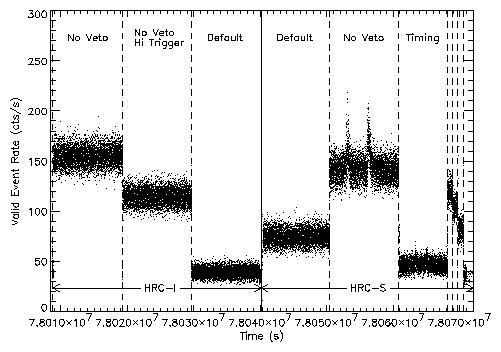Telemetered vs Processed Events
In addition to the data for individual events, the HRC has scalars
that report the rate of MCP triggers and the rate of triggers that
pass on-board validity tests; these are known as the "Total" and
"Valid" event rates. These rates are useful in determining the
detector deadtime, particularly when
the event rate exceeds the bandwidth available for telemetry. The
telemetered values are recorded in the HRC level 0
hrcf*_ss0.fits file. During level 1 processing, the
two 1.0 second samples of the total and valid event scalars for a
given HRC science frame are summed and output into the
hrcf*_dtf1.fits file in column names
TOTAL_EVT_COUNT and VALID_EVT_COUNT. A
count of the telemetered events whose time-tags indicate that they
occurred during the 2.0 seconds covered by the scalar is also added
to the hrcf*_dtf1.fits file as
PROC_EVT_COUNT. As long as the rate is low enough
that we are not telemetry saturated the value of
PROC_EVT_COUNT should be nearly the same as
VALID_EVT_COUNT since essentially all the valid
events can make it into the on-board FIFO and out in
telemetry. This appears to be true for the HRC-I; however, it is
not the case for the HRC-S.
There is a significant fraction of events on the HRC-S that are
counted as valid by the rate scalar that do not get
telemetered. This fraction is a configuration dependent. A good
data set to view the difference between the HRC-I and HRC-S and
the effect of the HRC-S configuration is a sequence of calibration
observations of PSR B0540-69 performed in 2000 June to evaluate
possible solutions to the HRC timing problem. Table 1 provides a
listing of the observations with the relevant configuration changes.
Table 1: PSR B0540-69 Observations -
Sequential Order
| Detector | ObsID | Antico Veto | Edge-blank |
Specmode | Trigger Level |
|---|
| HRC-I | 1735 | DISA | DISA | SPEC | 8 |
| 1736 | DISA | DISA | SPEC | 64 |
| 1741 | ENAB | DISA | SPEC | 8 |
| HRC-S | 1737 | DISA | ENAB | SPEC | 8 |
| 1738 | DISA | DISA | SPEC | 8 |
| 1745 | DISA | DISA | IMAG | 21 |
| 1739 | DISA | DISA | SPEC | 21 |
| 1742 | DISA | DISA | SPEC | 48 |
| 1743 | DISA | DISA | IMAG | 8 |
| 1744 | DISA | DISA | IMAG | 48 |
Figures 1-3 show the total, valid, and telemetered rates for this
sequence of observations. The effect of the detector configuration
changes can be seen on the rates: the total rate on the HRC-I
drops when the trigger level is raised and it drops on the HRC-S
when "imaging-mode is selected and the trigger level raised for
Timing mode.

|
|
Figure 1: Total event rate for 2000 June 20-21 observations of
PSR B0540-69 using the HRC-I and HRC-S under a variety of
configurations. Dashed vertical lines separate the individual
observations. The configurations for the longer observations are
briefly indicated by text in the plot; see table 1 for details of
these and the shorter observations.
|

|
|
Figure 2: Valid event rate for 2000 June 20-21 observations of
PSR B0540-69. Similar to figure 1.
|

|
|
Figure 3: Telemetered event rate for 2000 June 20-21 observations of
PSR B0540-69. Similar to figure 1.
|
Figure 4 shows the ratio of the telemetered event rate to the reported
valid event rate. For the HRC-I, the ratio is near 1.0 as expected
for the observed rates; the different appearance of the HRC-I
default comfiguration is most likely due to the event time-tagging
problem. The ratio on the HRC-S is much different from 1.0 without
any noticible change in the rates. Selecting HRC-S imaging mode
and/or raising the trigger level moves the ratio closer to
1.0.

|
|
Figure 4: Telemetered/valid event rate for 2000 June 20-21
observations of PSR B0540-69. Note that for the HRC-S a significant
fraction of the contributors to the valid event rate do not get telemetered.
|
Another possible HRC-S configuration change that we can look
at is using the edge-blanking function for the selection of the
individual MCP segments. Figure 5 shows the telemetered to valid
rate ratio for a series of observations of G21.5-0.9 where this
was done. We have performed this test three times and the data
shown are for the first instance in 1999 September. The data were
slightly affected by flaring in the background but the general
result that the three MCP segments differ in the ratio is not
significantly affected.

|
|
Figure 5: Comparison of the telemetered/valid event rate among
the three HRC-S MCP segments from the 1999 September 5 observations
of G21.5-0.9 (ObsIDs 147, 151, and 157). The individual segments were
selected using edge-blanking regions.
|
Speculation
One way that I can see to produce the discrepancy in the valid and
telemetered rates on the HRC-S is if an over-shoot on sufficiently
large pulses causes double counting in the total and valid
rates. The fraction that are double counted would drop as the
trigger level is raised. There might possibly be differences in
the pulse shapes and possibility of over-shoot among the MCP
segments that causes the different ratios between the segments.
The difference here would be yet another useful thing to investigate
on the flight-spare detector assembly and POC electronics.
Last modified: Fri Dec 7 12:35:11 EST 2001
Dr. Michael Juda
Harvard-Smithsonian Center for Astrophysics
60 Garden Street, Mail Stop 70
Cambridge, MA 02138, USA
Ph.: (617) 495-7062
Fax: (617) 495-7356
mjuda@cfa.harvard.edu




